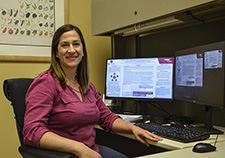Office of Research & Development |
 |


VA researchers and colleagues are studying what physicians can do to maintain good communication and rapport with patients even as they [the physicians] engage with the electronic health record on their computer. (Photo: ©iStock/wutwhanfoto)
March 13, 2018
By Mike Richman
VA Research Communications
"In many ways, the conversation is much like a dance."
Many patients find it unsettling.
You’re in an office hoping to consult with a doctor, who instead is preoccupied with entering your medical data into a computer and doesn’t talk or make eye contact.
You may ask yourself: Is the doctor uninterested in my health concerns? Will my questions be answered before I leave the office? Should I find another doctor?
Evidence is mixed on how doctors’ use of computers in the exam room, specifically to enter data into electronic health records (EHRs), affects their ability to communicate with patients.
With this in mind, researchers investigated how physician interaction with the computer—mouse clicks, key strokes, and gaze, or looking intently at the screen—impacts patient participation in the discussion.

VA ear surgeon studies management of severe hearing loss in Veterans

Veteran disability payments led to fewer hospitalizations

Air Force Veteran among 10 new awardees in VA diversity, equity, and inclusion research program

VA researcher leads project to evaluate Veteran screening for malnutrition
One study finds that patients were less active participants in consultations in which doctors engaged in more keyboard activity. More gaze at the computer was also linked to greater silence in the discussion. Physician efforts to generate conversation by asking about a patient’s concerns or soliciting questions, for example, led to a higher level of patient participation.
Dr. Richard Street, a communication researcher at the Michael E. DeBakey VA Medical Center in Houston, led the study. It appeared online in the Journal of General Internal Medicine in November 2017.
Street says there are communications techniques that most doctors need to include in their consultations with patients.
“In many ways, the conversation is much like a dance,” he says. “Each party has its roles and responsibilities and needs to work together. While much is fairly predictable, there is also a good bit of improvisation on the part of providers and patients that is associated with different communicative styles and agendas.”
When a patient is seeing a doctor for the first time, he explains, clinician-patient interaction has a “huge” impact on a patient gaining respect for and confidence in the physician.
“However, as one continues to see a particular doctor, more of our confidence and respect for him or her will be determined by the collective of our previous interactions with them,” Street says. “This doesn’t mean that the clinician-patient interaction is not important in an established relationship. It’s just that it is weighed against the backdrop of previous experiences.”
He adds that a lack of eye contact by the doctor “isn’t bad in and of itself unless it is extreme,” which means the physician rarely looks at the patient. “In that respect, patients may differ on how much of the conversation the doctor needs to be looking at them,” he says.
Street and his colleagues suggest ways doctors can improve their communication with patients.
“Using easy-to-deploy communication tactics while working on the computer—[such as] asking about a patient’s thoughts and concerns or maintaining social conversation—can help physicians engage patients, as well as maintain conversational flow,” the researchers write. “Models exist for teaching clinicians communicative practices and consultation management techniques that maintain engagement with the patient and enable task completion in the EHR.”
The researchers offer the following suggestions, among others:
In addition to VA, Street holds academic affiliations at Texas A&M University and the Baylor College of Medicine in Houston. His research focuses on doctor-patient communication, pathways linking communication to improved health outcomes, and strategies for increasing patient involvement in health care.
He and his team authored two previous VA-funded studies on doctor-patient interaction.
In one of the studies, observers watching video recordings of medical consultations rated doctors as having poorer communication skills when they spent more time gazing at the computer and when the consultation included more periods of silence. The study appeared in 2014 in Patient Education and Counseling.
Another study appeared in 2015 in The Journal of Family Practice. Researchers analyzed patient satisfaction scores in relation to nonverbal behaviors by doctors, finding that more clinician gaze time at the patient translated into greater patient satisfaction.
Both studies involved VA doctors and patients.
Street’s most recent study extended the previous two by looking at how doctor interaction with the electronic health record affected patient communication and physician efforts to facilitate patient participation. Plus, the study used VA and non-VA participants.
The study included video recordings and computer tracking of key stroke and mouse click activity in primary care and specialty consultations, with 32 doctors making 217 visits. The number of visits was evenly split between the VA San Diego Healthcare System and the University of California, San Diego (UCSD). The average visit length was 20 minutes.
The patients averaged 61 years in age. The 32 physicians averaged eight years of experience with EHR activity.
Controlling for visit length, the researchers linked more keyboard clicks with less patient communication. Longer visits meant more patient participation.
The investigators also learned that doctors at VA San Diego made greater efforts than the physicians at UCSD to generate conversation with patients, especially with female and older patients. There was no major tie between mouse clicks, key strokes, or gaze time and physician attempts to communicate verbally with patients.
Street finds no clear-cut difference between the speed with which doctors work and the attention they pay to patients at VA facilities versus private practices.
“So many things come into play,” he says. “Some private practices are like factories and yet others are like boutiques. I assume one CBOC [a VA community-based outpatient clinic] may have a much heavier work flow than another. Then there are large VA medical centers. So it’s hard to boil it down to something really simple.”
To advance their knowledge of doctor-patient interaction, Street and his colleagues call for future research that explores what EHR activity and certain elements of clinician-patient communication mean from the perspective of patients.
One study, Street says, could involve folding computer activity into the conversation through graphs, tables, or charts to see if there is an impact on communication. In another study, a patient would watch a video recording of a medical visit, then reflect on what he or she saw in the doctor’s computer activity.
So if you ever feel your doctor is paying too much attention to the computer and not enough to you, rest assured that at least researchers are studying the problem, and working to help open those all-important lines of doctor-patient communication.
VA Research Currents archives || Sign up for VA Research updates